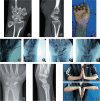Comparison of Two Different Percutaneous Screw Fixations for Treating Herbert B2-Type Acute Scaphoid Fractures
- PMID: 36254105
- PMCID: PMC9732583
- DOI: 10.1111/os.13517
Comparison of Two Different Percutaneous Screw Fixations for Treating Herbert B2-Type Acute Scaphoid Fractures
Abstract
Objective: Scaphoid fracture was the most common carpal fracture and the most challenging. The purpose of this study was to investigate and compare the clinical effects of closed reduction and percutaneous cannulated screw internal fixation under fluoroscopy and arthroscopy-assisted percutaneous cannulated screw internal fixation in the treatment of Herbert B2-type of acute scaphoid fractures.
Methods: A retrospective controlled study was conducted on 29 patients with Herbert B2-type acute scaphoid fracture with a displacement of >1 mm admitted to our hospital from January 2017 to June 2021. Patients were divided into two groups, 11 patients were treated with closed reduction percutaneous cannulated screw internal fixation under fluoroscopy and 18 patients were treated with percutaneous cannulated screw internal fixation assisted by arthroscopy. The operative time, intraoperative fluoroscopy times, fracture healing time, complications, and postoperative wrist function score of the two groups were compared.
Results: All patients were followed up for 6-18 months (mean follow-up duration: 10.38 ± 2.69 months). The respective operation times in the arthroscopy group and fluoroscopy group was 51.50 ± 6.69 min and 56.73 ± 11.48 min, respectively (p > 0.05). The number of fluoroscopies performed in the arthroscopy group was (6.83 ± 1.30), which was less than that in the fluoroscopy group (10.91 ± 2.62) (p < 0.05). All fractures in the arthroscopy group healed after the operation, and the fracture healing time was 11.44 ± 1.25W. Ten patients in the fluoroscopy group healed. The fracture healing time was 13.60 ± 2.32 W. The fracture healing time in arthroscopy group was less than that in the fluoroscopy group (p < 0.05). One patient in the fluoroscopy group had nonunion and healed after bone grafting and internal fixation. At the postoperative 6-month follow-up, the modified Mayo wrist function score was used to evaluate the clinical results. The wrist function score of patients in the arthroscopy group was 90 (85, 95), which was >80 (80, 90) in the fluoroscopy group (z = 2.74, p < 0.05).
Conclusion: For Herbert B2-type acute scaphoid fracture with fracture displacement > 1 mm, the arthroscopy-assisted percutaneous cannulated screw internal fixation has less fluoroscopy times, short fracture healing time, and good recovery effect of wrist function compared to the fluoroscopy.
Keywords: bone; carpal arthroscopy; percutaneous screw internal fixation; scaphoid fracture; scaphoid nonunion.
© 2022 The Authors. Orthopaedic Surgery published by Tianjin Hospital and John Wiley & Sons Australia, Ltd.
Figures



Similar articles
-
[Treatment of acute non-displaced scaphoid fracture of wrist with syringe needle-guided percutaneous cannulated headless hollow compression screw internal fixation].Zhongguo Gu Shang. 2023 Feb 25;36(2):161-4. doi: 10.12200/j.issn.1003-0034.2023.02.013. Zhongguo Gu Shang. 2023. PMID: 36825418 Chinese.
-
Robot-assisted vs traditional percutaneous freehand for the scaphoid fracture treatment: a retrospective study.Int Orthop. 2023 Mar;47(3):839-845. doi: 10.1007/s00264-022-05532-9. Epub 2022 Aug 4. Int Orthop. 2023. PMID: 35922521 Free PMC article.
-
[Arthroscopic treatment of scaphoid fracture nonunion with bone graft and Kirschner wire combined with screw fixation].Zhongguo Xiu Fu Chong Jian Wai Ke Za Zhi. 2023 Nov 15;37(11):1386-1389. doi: 10.7507/1002-1892.202307059. Zhongguo Xiu Fu Chong Jian Wai Ke Za Zhi. 2023. PMID: 37987049 Free PMC article. Chinese.
-
Which is the Best Solution for Achieving Maximal Interfragmentary Compression of the Scaphoid Fractures - One or Two Herbert Screws?Acta Chir Orthop Traumatol Cech. 2023;90(1):34-40. Acta Chir Orthop Traumatol Cech. 2023. PMID: 36907581 Review. English.
-
Percutaneous fixation of scaphoid fractures.Hand Clin. 2001 Nov;17(4):553-74. Hand Clin. 2001. PMID: 11775468 Review.
Cited by
-
Surgical treatment of carpal scaphoid non-union: a systematic review.Eur J Orthop Surg Traumatol. 2025 Jul 2;35(1):287. doi: 10.1007/s00590-025-04410-5. Eur J Orthop Surg Traumatol. 2025. PMID: 40603779 Review.
-
Comparison of arthroscopy-assisted versus open reduction and fixation for treating scaphoid fractures.BMC Surg. 2025 May 28;25(1):232. doi: 10.1186/s12893-025-02961-2. BMC Surg. 2025. PMID: 40437431 Free PMC article.
References
-
- Urch EY, Lee SK. Carpal fractures other than scaphoid. Clin Sports Med. 2015;34:51–67. - PubMed
-
- Sabbagh MD, Morsy M, Moran SL. Diagnosis and Management of Acute Scaphoid Fractures. Hand Clin. 2019;35:259–69. - PubMed
-
- Duckworth AD, Jenkins PJ, Aitken SA, et al. Scaphoid fracture epidemiology. J Trauma Acute Care Surg. 2012;72:E41–5. - PubMed
-
- Zaraa M, Ben Slama S, Mahjoub S, Sehli H, Hadj Salah M, Mbarek M. The head to foot screw fixation. A new technique of percutaneous screw fixation of the scaphoid bone. Tunis Med. 2017;95:60–6. - PubMed
-
- Kaneshiro SA, Failla JM, Tahman S. Scaphoid fracture displacement with forearm rotationin a short arm thumb spicacast. J Hand Surg. 1999;24:354–7. - PubMed
MeSH terms
LinkOut - more resources
Full Text Sources
Medical

